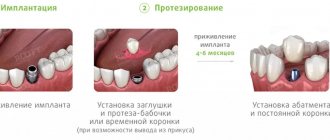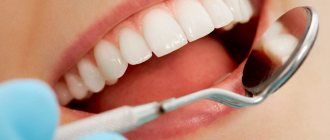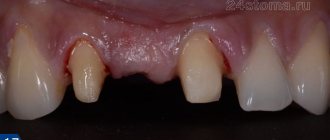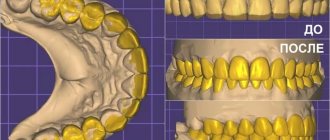Restoring the lower front tooth using a CEREC inlay
The work was quite serious. The tooth under the filling and the root of the lower canine were affected by caries.
First I removed the filling:
Then I removed the anchor pin:
In the video below you can see how the anchor pin was removed, and then I got ahead of myself a little, showing you a fitting of the finished CEREC module on the lower canine:
The next step was to go deep enough into the root, because the root of the lower canine was in caries.
IMPORTANT!
Each stage described above was accompanied by
3D scanning
with a Dentsply Sirona scanner, this is one of the best scanners in the world. The CEREC technological complex is equipped with just such a scanner. Scanning each stage, the CEREC hardware system stores all the data in memory, and when the time comes to plan and manufacture the missing tooth module, CEREC does this with filigree precision down to hundredths of a millimeter.
See for yourself by watching this short video:
Watch the video as I trace the border of this tooth.
The destroyed lower canine has a very complex geometry. However, the tooth will be completed using the “tooth only and missing module only” system. The canine will be installed and we will have a tooth that consists of only two components, no metal with one seam. The result will be a perfect lower canine. The restoration conditions are very difficult, deep, but in principle in this system it does not matter how deep they are, the main thing is that the tooth tissue is healthy. Our root has no caries, it has the classic dark color of the root, a non-carious color. Complex volumetric geometry in this tooth.
I create a tooth
, which will play the role of a reliable and strong fang for our patient. It has a super secure connection because there is only one seam, not two. In the video you can also watch the upper jaw, how we will close the teeth. You can also view contact points.
Yes, a very difficult tooth for a classic restoration. Difficult, but not for us. In CEREC, with a sufficiently professional level of the doctor, everything looks like “everything is the same”: this tooth for the Cerec system is simple like all the others. Well, in reality, of course, it looks and all the work looks fantastic:
As a result of the preparatory work I carried out, only the root of the lower canine 3.3 remained from intact tissue, and I made the missing module for it using CEREC technology: only the tooth and only the missing module without any anchor pins. It is this approach, without intermediaries in the form of pins, that ensures the best quality of treatment and further use of the tooth.
I created a CEREC inlay in A3.5 color with a color transition from the gum to the incisal edge. This transition ensured the absolute naturalness of the final design and the aesthetics of the tooth.
Sergey Samsakov
Removing the pins
Author: Ronald Forde
Root canals of endodontically treated teeth often contain broken instruments (instruments, silver posts, Lentulo, broken pins, etc.). The ability to remove broken instruments from the root system partially determines the success of root canal treatment. Abbott demonstrated that 9.4% of patients in an endodontic practice present for endodontic post extraction. Many factors influence the success of post removal, namely: the clinician's experience and choice of extraction technique and knowledge of tooth morphology, the type of cement used for luting, the shape (active or passive) and the type of post used (standard or customized).
When a hard object needs to be removed from a root canal, most general dentists refer such cases to an endodontist. Removing intact or broken pins is particularly difficult because previously prepared teeth have already been weakened by loss of hard tissue. Because dentists may have had little or no experience in removing posts, they are often concerned about the possibility of root fracture while attempting to remove the post, or they may not have the appropriate equipment for such a procedure. Many endodontists are also concerned about the possibility of root fracture when removing cemented posts, or they may believe that the extraction instrumentation is not up to the task.
According to Stamos and Gutmann, reasons for choosing a surgical approach include failure to remove or loosen the post after reasonable efforts have been made and cases where the post is large, long, or threaded and the crown and inlay appear intact. Quite often, the surgical approach carries its own problems (for example, intervention on the palatal root of a maxillary molar). In general, periapical surgery has a lower success rate than pin extraction.
If it is determined that an endodontically treated tooth is to be restored, the dentist must be aware of techniques for removing the foreign object from the canal and decide on the best solution for that particular situation. In reality, there is no true best method for all situations, and therefore the instrumentation and method of pin removal must be selected and tailored according to the situation. The goal will always be to preserve as much of the remaining tooth structure as possible. This factor is critical when working on a tooth where most of the root dentin has already been removed when the post was initially placed and the coronal portion has already been destroyed.
Pin removal tools have been on the market for a long time. They can be divided into 3 categories: mechanical, high-speed rotating and ultrasonic. It was and still is believed that pin extraction devices increase the risk of root fracture, although the Castrisos and Abbott study did not support this idea.
Attempting to remove pins or other foreign objects from a tooth canal may cause cracks, vertical root fracture, or perforation as a result of the direct mechanical effect of ultrasonic energy on the tooth structure. When any type of fracture occurs, it may be the formation of a new crack or from impact on a pre-existing weak point located on either the inner or outer surface of the root. It has been demonstrated that even the process of obturation of root canals creates intradentinal cracks. Altshul's study found that post removal using ultrasonic energy resulted in more root cracks (at the cemento-enamel junction) than in endodon.
Do you want to restore a tooth with a CEREC ceramic inlay?
8
or order a free call
Request a call
This is how the dental inlay for the lower canine turned out:
The inlay was fixed with double-curing cement Relix U200 (RelyX U200) - this is one of the most expensive cements, German cement. The patient was super satisfied. The restored tooth looks like its own:
All work FROM and TO was carried out in 1 appointment
, on a fresh tooth surface. Great job.
PS
As you can see in the video, the patient is facing the next stage of dental restoration. But we'll talk about this some other time.
Author:
Sergey Samsakov
orthopedic dentist
born 02/02/1989
Education:
2011 — Graduated from the Moscow State Medical and Dental University named after. A.I.Evdokimova
2012 — Internship in the specialty “Orthopedic Dentistry”, Moscow State Medical University named after. A.I.Evdokimova
2014 - Residency in Orthopedic Dentistry, Moscow State Medical University named after. A.I.Evdokimova
Tab
This is also a prosthetic design that imitates part of a tooth. Used for teeth located behind the canine teeth.
There are:
- Restorative inlays - to recreate the correct shape, bite and natural shade of the tooth;
- Stump inlays are placed under the crown and serve as the foundation for it.
The difference from the pin is in the device - the inlays consist of two parts - the pin itself and an element that replicates the tooth. The manufacturing process takes place under pressure at high temperatures. The root part is an attachment for the root and looks like a rod. The upper element follows the shape of a crown.
More examples of treatment
Caries under filling Depulped tooth Absence of the crown part of the tooth
Restoring a tooth with a CEREC inlay after removing a metal inlay
Tooth 3.5 initially had a filling; a metal inlay was installed in the tooth, quite deep, and a filling on top. This is a “puff sandwich”.
Module crown + tooth root CEREC Removal of metal inlay
more details
Pulpless tooth Destruction of the front tooth in the upper jaw
Restoring a front tooth damaged by super glue with a CEREC inlay
Superglue is toxic to the body. Is it possible to glue a piece of tooth with this glue? Of course not. But you can easily ruin a tooth!
Module crown + tooth root CEREC Professional hygiene
more details
How to build teeth onto pins, what is this process?
Prosthetics are performed after the pin is installed. Nowadays in dentistry, modern materials are used to make prosthetics; crowns are installed, as well as bridge prostheses if several teeth have been damaged at once.
First, the doctor must shape the filling material into the tooth around the post. It is shaped, filed and polished. What the result will be depends primarily on the experience of the dentist who works with this problem.
- Frequent urination or why do I pee so often?
If the tooth is seriously damaged, a crown is installed. It is a special prosthesis that cannot be removed and is performed individually for each patient. Usually the cost of crowns is quite high.
If the tooth is seriously damaged, a crown is installed
The entire prosthesis imitates a damaged tooth. It is fixed on the pin using a special strengthening solution. After the crown is installed, some time must pass. Then the doctor checks whether her body rejects it or not. Implantation is considered successful if the prosthesis is installed tightly and there are no signs of inflammation.
Do you want to restore a tooth with a CEREC ceramic inlay?
Always at your service - Sergey Samsakov, orthopedic dentist with more than 10 years of successful experience, Moscow. Expert in 3D digital smile modeling, veneers and CEREC technology.
Patients come to me from all over Russia:
Differences
- The pin puts pressure on the root of the tooth, which can cause it to become loose; there is pressure on adjacent teeth, and the inlay eliminates this load.
- Time of use - the pin can be used for up to 3 years, the inlay - much longer, almost 10 years.
- The pin is a single design, but the tab can separate.
- It is not difficult to make a pin, but to make an inlay, laboratory specialists are involved and special studies are carried out.
- The installation of the pin is carried out in one visit to the dentist; to install the inlay, you will have to visit the doctor at least twice.
- If the tooth has a crooked root, you can only use an inlay.
- The cost of an inlay is significantly higher than a pin.
- Preparing the tooth for the installation of a pin is relatively gentle; in order to install the inlay, a large amount of tissue is removed.
Bonding the prosthesis
If the crown on a tooth wobbles, you cannot loosen it even more on your own. It is better to seek help from the dentist who installed the pin. He will give the right recommendations and correct his work. If the crown falls out, it must be saved, placed in a safe place, and immediately contact your dentist. The tooth stump is very fragile, so there is always a danger of damaging it. Before installing the pins, the teeth must be carefully protected. Do not place a large chewing load on the prosthesis.
Many patients wonder if the crown has come off a tooth, what to do with it. This cannot be done, because it can harm the integrity of your teeth. The dentist may void the warranty on his or her work. Before visiting the doctor, carefully clean the stump and rinse your mouth with antiseptic compounds. If a complication occurs, the orthopedic structure is preserved and cannot be thrown away. It is placed in a box or container where the prosthesis will not be damaged or deformed. After the pin falls out, a hole remains in the gum, which must be closed with a piece of cotton wool while eating.
It is strictly not recommended to glue lost teeth with cement or dental compound yourself. If it is not possible to visit the dentist in the near future, you can temporarily use the painkillers described above. Inept use of medications to independently install a temporary filling can cause irreparable harm to your health.
Theoretically, the cement medicament can hold the crown in place for about two weeks, but it can damage the teeth. The patient will not be able to install the crown on his own and carefully get rid of the old cement.
If the crown is loose or the pin has fallen out, it is not recommended to take any action at home to install the structure in its place. You should immediately contact your doctor for professional help. Only he will be able to prescribe the correct treatment and establish the reasons why the trouble occurred.
Is it possible to glue a crown at home?
To place a crown or bridge, dentists use special materials that allow the orthodontic product to be temporarily or permanently secured.
Temporary type fixation is used to provide an opportunity to evaluate the structure while it is being worn. If there are no problems, the product is attached to permanent cement.
However, there are often cases when the crown falls out at home. The patient immediately begins to panic, especially if the crown was placed in the frontal area. In this case, there is no need to worry too much.
Why can our articles be trusted?
We make health information clear, accessible and relevant.
- All articles are checked by practicing doctors.
- We take scientific literature and the latest research as a basis.
- We publish detailed articles that answer all questions.
To glue the product in place, you can purchase a gel at the pharmacy, which is similar in composition to the temporary cement used by orthopedists. It is applied from the inside and pressed against the tooth. After the material has hardened, the excess is carefully removed.
To get a permanent crown, it is important to visit your dentist without delay.










